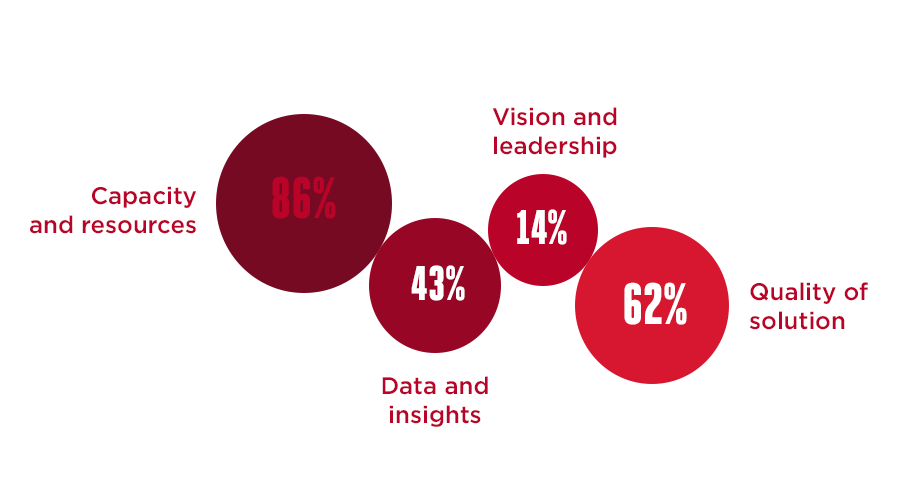Through grant funding and tailored technical assistance, the GSMA Innovation Fund works with start-ups and SMEs to help them scale operations and amplify their social and environmental impact.
In part two of our three-part blog series, we’re reviewing the biggest internal barriers to scale faced by the alumni in our cohort, using in-depth interview data collected at the end of their funded projects.
Internal barriers to scale refer to challenges that hinder growth but don’t involve external actors. From our analysis, these barriers are:

Vision and leadership can be challenging to identify within a team. While many start-ups have a defined vision, it can become fluid as they grow. And even for those whose vision stays constant; it is difficult to communicate that vision to the broader team and ensure they understand it.
Of all internal challenges, this was the least frequently cited as a current barrier for scale by our alumni cohort (14%). Those that are experiencing it notice it as their team grows. They report that new employees, especially in roles such as sales agents and drivers, are less likely to be working alongside company leadership and more likely to have cultural and language barriers. This results in reduced collaboration and productivity and needs to be addressed through training or team bonding. Some alumni are dealing with this during recruitment by scoring applicants on their understanding of the company’s mission.
Data and insights are important to any business, but we’ve focused our analysis on when the lack of data creates a barrier to growth. Start-ups most commonly experience this when they cannot get information about their current or potential users. For those that target vulnerable communities, such as persons with disabilities, those below the poverty line, or people without access to a smartphone, it is not always possible to source data about the demographic. This makes market sizing extremely expensive, as start-ups need to collect the data themselves. Start-ups may also lack data about their current users. Unless they’re actively seeking feedback from their user base, they won’t have insight into the challenges faced by users when interacting with the product – challenges that can ultimately result in user drop-off.
Just under half of our alumni (43%) reported that data and insights are a current barrier for scale. While addressing this barrier requires investing in data collection, databases, and analysis, or forming partnerships that can achieve this, it provides priceless insights. Several alumni report that data and insights is not a barrier, but is in fact, their greatest strength. Especially in markets where user data is not easily available, a start-up with this data stands above their competitors.
The quality of the solution for each alumnus often depends on where they sit in their scaling journey. For those who have just finished a pilot or are actively adding new features, this is a common barrier. However, most alumni say there will always be room to improve the quality of their solution, even if the issues aren’t significant enough to be a barrier to growth.
More than half of alumni (62%) reported this as a current barrier. To understand how it can be improved, user feedback is critical. As part of the GSMA Innovation Fund, alumni work with third-party providers to conduct surveys of their users. By working with a third-party, the survey has less bias and is more likely to collect honest feedback. However, bugs in the technology can persist regardless of how much a company is aware of them. For some alumni, this will continue to be a barrier until they can increase the size and capacity of their team.
Capacity and resources can become a barrier for start-ups in many ways. In our analysis, we focus on two main challenges: capacity of the team (staff) and financial resources (funding runway). The two often rely on each other, as a bigger team is needed to reach a larger user base, and a larger user base can bring in more revenue. However, funding is needed to hire staff, especially skilled employees.
Most alumni (86%) report capacity and resources as a current barrier to scale. In the countries where they operate, finding and recruiting senior-level and highly skilled staff is challenging. Because of their status as an early-stage social enterprise, they are unable to compete with the salaries and benefits of larger corporations. For some, scaling is heavily reliant on personnel and their plans to onboard more users are entirely dependent on having a team to support it. Financial restraints are also a challenge for alumni, especially those that require hardware or physical assets to grow. Refining a physical product and mass producing it is often more expensive than scaling software. Some alumni have reported their future growth is entirely dependent on funding, with some noting that they aren’t able to meet current demand because of financial restraints.
More than all other internal challenges, addressing capacity and resources often relies on external support from donors, partners, and investors. However, alumni have innovated and overcome this barrier internally by diversifying revenue and creating incentives for employees to join and stay on their teams.
In our next and final blog in this series, we’ll explore the top external barriers to scale for our start-up alumni.
This initiative is currently funded by UK International Development from the UK government and the Swedish International Development Cooperation Agency (Sida), and is supported by the GSMA and its members.




